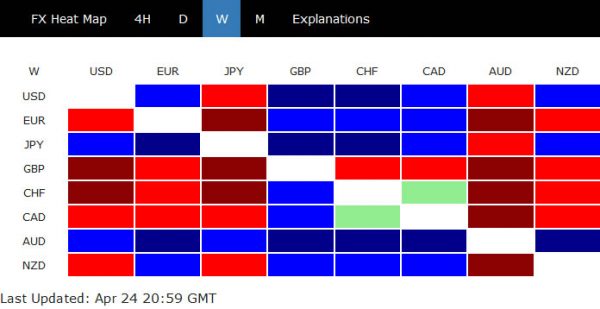The unimaginable negative oil price was the biggest head-liner last week. But the impact on other markets were relatively short lived. Canadian Dollar was much bothered for most of the week, but eventually it’s just the second worst performing, following Sterling. On the other hand, Australian Dollar ended as the strongest, followed by Yen, and that’s a sign of indecisiveness during consolidation in risk markets.
Developments of the coronavirus pandemic will remain a major factor for investor decisions for the near term. Daily deaths appeared to be flattening globally, which is a good sign. US cases surged mainly due to intensified testing while daily deaths steadied. Italy, Spain and France continued to show improvements. But major risks are now observed in Mexico, Brazil, Russia, and to a lesser extent Turkey.
After unprecedented move, WTI oil would still spiral lower in orderly fashion
Oil prices suffered unprecedented turbulence last week, as May WTI crude oil contract tumbled into negatively, hitting as low as -40.32. The lack of qualified storage to keep the overwhelmed supply surplus was true, but the move was very much exaggerated by contract expiry too. June contract took up the spot light well and recovered to close at 16.94.
The extreme volatility is unlikely to repeat itself again, as traders are now psychologically prepared. Yet, there is no sign of trend reversal, at least until 19.46 support turned resistance is taken out decisively. WTI crude oil will more likely spiral downward again, in much orderly fashion though.
Dollar index failed to break 100.93 resistance, risk of another fall remains
Dollar index initially tried to ride on loss of upside moment momentum in risk markets. But there was no follow through buying to push it through 100.93 resistance. Risk remains for corrective pattern from 102.99 to extend with another falling leg. Break of 55 day EMA (now at 99.33 will target 98.27 support. Though, we’d expects strong support from 61.8% retracement of 94.65 to 102.99 at 97.83 to contain downside and bring rebound. Meanwhile, break of 100.93 could pave the way to a retest on 102.99 high.
A look at the rebound in major stocks as hints on investor confidence
There were lots of talks on the shape of the upcoming recovery, V or U. But such discussions would remain rather academic until we finally see the end of the coronavirus pandemic, for every country since it’s a highly connected world. Normally, the stock markets and respective currencies don’t have very close correlations. Yet, going ahead, underlying investor confidence might provide some hints on the the next move in the currency markets. After all, economic recovery is also a confidence thing. If that’s that case, Sterling and Aussie could lag behind others in the next move.
Australia ASX’s decline last week suggests that corrective recovery from 4429.10 has completed at 5618.10, after breaching 38.2% retracement of 7289.7 to 4429.1 at 5521.84, ahead of 55 day EMA. Break of 5063.5 support will solidify this case and bring retest of 4429.10 low.
Staying in Asia pacific, Nikkei’s rebound was similar, as 38.2% retracement of 24108.10 to 16358.19 was taken out. Though, it’s still limited well below 55 day EMA. Last week’s fall was the first sign of completion of the corrective rise. Break of last week’s low at 18858.25 will build up the case for retesting 16358.19 low.
Over to Europe, FTSE’s recovery was relatively weak as it couldn’t even reach 38.2% retracement of 7689.66 to 4898.79 at 5964.90 yet. Though, there is no clear sign of topping and another rise might still be seen. However, break of 5396.66 support will bring retest of 4898.79 low.
DAX’s performance was slightly better at 38.2% retracement of 13795.24 was taken out, but not 55 day EMA. There was no sign of topping too. But break of 9337.01 will bring retest of 8255.65 low.
DOW’s performance was actually the best among the above major indices discussed. 50% retracement of 29568.57 to 18213.65 at 23891.1 was hit, as well as 55 day EMA. The initial dip last week raised the chance of near term reversal but there was no follow through selling. Focus will be on 22595.06 resistance turned support this week. Break there will indicate rejection by 55 day EMA and bring retest of 18213.65 low.
EUR/JPY dropped to as low as 115.54 last week and the break of 116.12 support confirms resumption of fall from 122.87. More importantly, break of 115.86 low suggests larger down trend resumption. Nevertheless, as a temporary low was formed with subsequently, initial bias is neutral this week for consolidations first. Upside should be limited by 117.21 resistance to bring fall resumption. Break of 115.54 will target 100% projection of 121.14 to 116.33 from 119.00 at 114.19 next.
In the bigger picture, down trend from 137.49 (2018 high) is possibly resuming. Medium term bearishness is maintained with the cross staying well inside falling channel established since 137.49 (2018 high), as well as below falling 55 week EMA. Next downside target will be 109.48 (2016 low). In any case, outlook will remain bearish as long as 122.87 resistance holds, in case of rebound.
In the long term picture, EUR/JPY is staying in long term sideway pattern, established since 2000. Fall from 137.49 is seen as a falling leg inside the pattern. This falling leg would target 109.48 (2016 low). With EUR/JPY staying below 55 month EMA (now at 124.80), this is the preferred case.


 Signal2forex.com - Best Forex robots and signals
Signal2forex.com - Best Forex robots and signals




